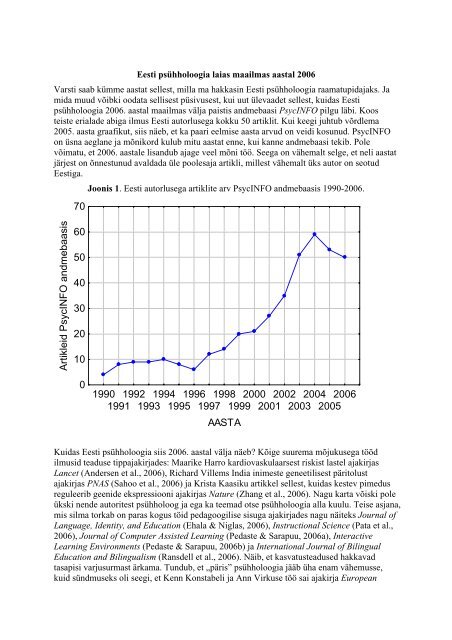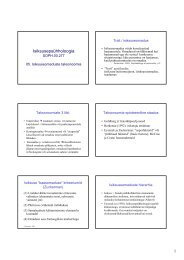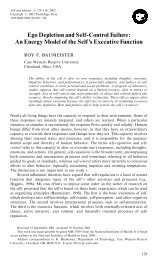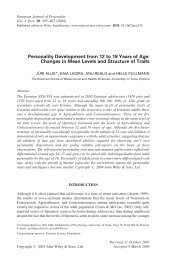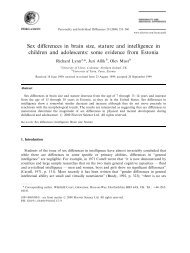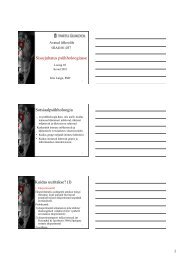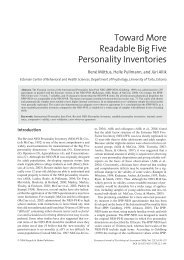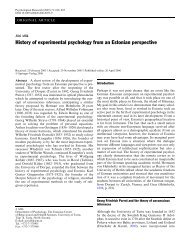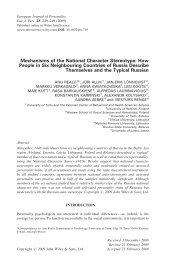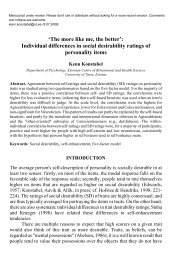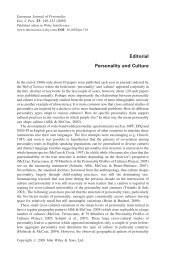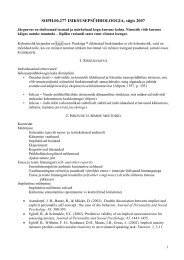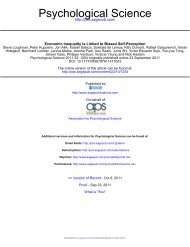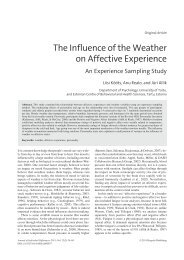1990 1991 1992 1993 1994 1995 1996 1997 1998 1999 2000 2001 ...
1990 1991 1992 1993 1994 1995 1996 1997 1998 1999 2000 2001 ...
1990 1991 1992 1993 1994 1995 1996 1997 1998 1999 2000 2001 ...
- No tags were found...
Create successful ePaper yourself
Turn your PDF publications into a flip-book with our unique Google optimized e-Paper software.
Eesti psühholoogia laias maailmas aastal 2006Varsti saab kümme aastat sellest, milla ma hakkasin Eesti psühholoogia raamatupidajaks. Jamida muud võibki oodata sellisest püsivusest, kui uut ülevaadet sellest, kuidas Eestipsühholoogia 2006. aastal maailmas välja paistis andmebaasi PsycINFO pilgu läbi. Koosteiste erialade abiga ilmus Eesti autorlusega kokku 50 artiklit. Kui keegi juhtub võrdlema2005. aasta graafikut, siis näeb, et ka paari eelmise aasta arvud on veidi kosunud. PsycINFOon üsna aeglane ja mõnikord kulub mitu aastat enne, kui kanne andmebaasi tekib. Polevõimatu, et 2006. aastale lisandub ajage veel mõni töö. Seega on vähemalt selge, et neli aastatjärjest on õnnestunud avaldada üle poolesaja artikli, millest vähemalt üks autor on seotudEestiga.Joonis 1. Eesti autorlusega artiklite arv PsycINFO andmebaasis <strong>1990</strong>-2006.70Artikleid PsycINFO andmebaasis6050403020100<strong>1990</strong> <strong>1992</strong> <strong>1994</strong> <strong>1996</strong> <strong>1998</strong> <strong>2000</strong> 2002 2004 2006<strong>1991</strong> <strong>1993</strong> <strong>1995</strong> <strong>1997</strong> <strong>1999</strong> <strong>2001</strong> 2003 2005AASTAKuidas Eesti psühholoogia siis 2006. aastal välja näeb? Kõige suurema mõjukusega töödilmusid teaduse tippajakirjades: Maarike Harro kardiovaskulaarsest riskist lastel ajakirjasLancet (Andersen et al., 2006), Richard Villems India inimeste geneetilisest päritolustajakirjas PNAS (Sahoo et al., 2006) ja Krista Kaasiku artikkel sellest, kuidas kestev pimedusreguleerib geenide ekspressiooni ajakirjas Nature (Zhang et al., 2006). Nagu karta võiski poleükski nende autoritest psühholoog ja ega ka teemad otse psühholoogia alla kuulu. Teise asjana,mis silma torkab on paras kogus töid pedagoogilise sisuga ajakirjades nagu näiteks Journal ofLanguage, Identity, and Education (Ehala & Niglas, 2006), Instructional Science (Pata et al.,2006), Journal of Computer Assisted Learning (Pedaste & Sarapuu, 2006a), InteractiveLearning Environments (Pedaste & Sarapuu, 2006b) ja International Journal of BilingualEducation and Bilingualism (Ransdell et al., 2006). Näib, et kasvatusteadused hakkavadtasapisi varjusurmast ärkama. Tundub, et „päris” psühholoogia jääb üha enam vähemusse,kuid sündmuseks oli seegi, et Kenn Konstabeli ja Ann Virkuse töö sai ajakirja European
2Journal of Personality aastapreemia doktoritöö põhjal valminud artiklite kategoorias(Konstabel & Virkus, 2006). Hea märk on kindlasti see, et autorite nimekirjas on päris nooripsühholooge (Merle Nurmoja, Ann Virkus, Carolina Murd, Kätlin Peets, Liisa Raudsepp jt.)Nii nagu mujal psühholoogias on kõige kindlam viis ennast nähtavaks teha uurides tervist võiseda, kuidas alkohol, rohud või enesetapu mõtted seda mõjutavad (Harro et al., 2006; Kull,2006; Kõlves, Värnik, Schneider et al., 2006; Kõlves, Värnik, Tooding et al., 2006; Lang etal., 2006; Põlluste et al., 2006; Vendt, 2006; Vendt et al., 2006; Õun et al., 2006; Ööpik et al.,2006).Kokkuvõte võiks olla selline: täiesti normaalne aasta!Jüri AllikEesti autorlusega publikatsioonid PsycINFO andmebaasis 2006Aavik, T., & Allik, J. (2006). Principles that People Seek to Avoid in Their Lives: PersonalValues with the Opposite Sign? Journal of Individual Differences, 27(4), 185-192.Abramov, U., Raud, S., Innos, J., Kõks, S., Matsui, T., & Vasar, E. (2006). Gender specificeffects of ethanol in mice, lacking CCK-sub-2 receptors. Behavioural Brain Research,175(1), 149-156.Allik, J. (2006). Personality dimensions across cultures. In T. A. Widiger, E. Simonsen, P. J.Sirovatka & D. A. Regier (Eds.), Dimensional models of personality disorders:Refining the research agenda for DSM-V. (pp. 117-132). Washington, DC, US:American Psychiatric Association.Allik, J., & McCrae, R. R. (2006). Erratum to Allik and McCrae. Journal of Cross-CulturalPsychology, 37(4), 485-485.Andersen, L. B., Harro, M., Sardinha, L. B., Froberg, K., Ekelund, U., Brage, S., et al. (2006).Physical activity and clustered cardiovascular risk in children: A cross-sectional study(The European Youth Heart Study). Lancet, 368(9532), 299-304.Areda, T., Raud, S., Philips, M.-A., Innos, J., Matsui, T., Kõks, S., et al. (2006). Cat odourexposure decreases exploratory activity and alters neuropeptide gene expression inCCK-sub-2 receptor deficient mice, but not in their wild-type littermates. BehaviouralBrain Research, 169(2), 212-219.Bachmann, T. (2006). Microgenesis of Perception: Conceptual, Psychophysical, andNeurobiological Aspects. In H. Ögmen & B. G. Breitmeyer (Eds.), The first halfsecond: The microgenesis and temporal dynamics of unconscious and consciousvisual processes. (pp. 11-33). Cambridge, MA, US: MIT Press.Bachmann, T., & Nurmoja, M. (2006). Are There Affordances of Suggestibility in FacialAppearance? Journal of Nonverbal Behavior, 30(2), 87-92.Ehala, M., & Niglas, K. (2006). Language Attitudes of Estonian Secondary School Students.Journal of Language, Identity, and Education, 5(3), 209-227.Harro, M., Oja, L., Tekkel, M., Aru, J., Villa, I., Liiv, K., et al. (2006). Monitoring physicalactivity in Baltic countries: The FINBALT study, HBSC and other surveys in youngpeople. Journal of Public Health, 14(2), 103-109.Koka, A., & Hein, V. (2006). Perceptions of Teachers' General and Informational Feedbackand Intrinsic Motivation in Physical Education: Two-Year Effects. Perceptual andMotor Skills, 103(2), 321-332.Konstabel, K., Aavik, T., & Allik, J. r. (2006). Social Desirability and Consensual Validity ofPersonality Traits. European Journal of Personality, 20(7), 549-566.
3Konstabel, K., & Virkus, A. (2006). How Similar Are the Conceptual and EmpiricalStructures of Personality Traits? European Journal of Personality, 20(5), 337-353.Kooskora, M. (2006). Perceptions of business purpose and responsibility in the context ofradical political and economic development: The case of Estonia. Business Ethics: AEuropean Review, 15(2), 183-199.Kreegipuu, K., Murd, C., & Allik, J. (2006). Detection of colour changes in a moving object.Vision Research, 46(11), 1848-1855.Kull, M. (2006). Health Inequality Among Estonian Women. Health Care for WomenInternational, 27(2), 112-124.Kõks, S., Nikopensius, T., Koido, K., Maron, E., Altmäe, S., Heinaste, E., et al. (2006).Analysis of SNP profiles in patients with major depressive disorder. InternationalJournal of Neuropsychopharmacology, 9(2), 167-174.Kõlves, K., Värnik, A., Schneider, B., Fritze, J., & Allik, J. (2006). Recent life events andsuicide: A case-control study in Tallinn and Frankfurt. Social Science & Medicine,62(11), 2887-2896.Kõlves, K., Värnik, A., Tooding, L.-M., & Wasserman, D. (2006). The role of alcohol insuicide: A case-control psychological autopsy study. Psychological Medicine, 36(7),923-930.Lahikainen, A. R., Kraav, I., Kirmanen, T., & Taimalu, M. (2006). Child-Parent Agreement inthe Assessment of Young Children's Fears: A Comparative Perspective. Journal ofCross-Cultural Psychology, 37(1), 100-119.Laidra, K., Allik, J., Harro, M., Merenäkk, L., & Harro, J. (2006). Agreement AmongAdolescents, Parents, and Teachers on Adolescent Personality. Assessment, 13(2),187-196.Lang, K., Väli, M., Szucs, S., Ádány, R., & McKee, M. (2006). The composition of surrogateand illegal alcohol products in Estonia. Alcohol and Alcoholism, 41(4), 446-450.Mõttus, R., Pullmann, H., & Allik, J. (2006). Toward More Readable Big Five PersonalityInventories. European Journal of Psychological Assessment, 22(3), 149-157.Mäestu, J., Jürimäe, J., Kreegipuu, K., & Jürimäe, T. (2006). Changes in Perceived Stress andRecovery During Heavy Training in Highly Trained Male Rowers. The SportPsychologist, 20(1), 24-39.Nahar, N., Lyytinen, K., Huda, N., & Muravyov, S. V. (2006). Success factors for informationtechnology supported international technology transfer: Finding expert consensus.Information & Management, 43(5), 663-677.Paaver, M., Eensoo, D., Pulver, A., & Harro, J. (2006). Adaptive and maladaptive impulsivity,platelet monoamine oxidase (MAO) activity and risk-admitting in different types ofrisky drivers. Psychopharmacology, 186(1), 32-40.Pastell, M., Aisla, A. M., Hautala, M., Poikalainen, V., Praks, J., Veermäe, I., et al. (2006).Contactless measurement of cow behavior in a milking robot. Behavior ResearchMethods, 38(3), 479-486.Pata, K., Lehtinen, E., & Sarapuu, T. (2006). Inter-relations of tutor's and peers' scaffoldingand decision-making discourse acts. Instructional Science, 34(4), 313-341.Pedaste, M., & Sarapuu, T. (2006a). Developing an effective support system for inquirylearning in a Web-based environment. Journal of Computer Assisted Learning, 22(1),47-62.Pedaste, M., & Sarapuu, T. (2006b). The factors influencing the outcome of solving storyproblems in a web-based learning environment. Interactive Learning Environments,14(2), 153-176.
4Peets, K., & Kikas, E. (2006). Aggressive strategies and victimization during adolescence:Grade and gender differences, and cross-informant agreement. Aggressive Behavior,32(1), 68-79.Platt, L., Bobrova, N., Rhodes, T., Uusküla, A., Parry, J. V., Rüütel, K., et al. (2006). HighHIV prevalence among injecting drug users in Estonia: Implications for understandingthe risk environment. AIDS, 20(16), 2120-2123.Pullmann, H., Raudsepp, L., & Allik, J. (2006). Stability and Change in Adolescents'Personality: A Longitudinal Study. European Journal of Personality, 20(6), 447-459.Purge, P., Jürimäe, J., & Jürimäe, T. (2006). Hormonal and psychological adaptation in elitemale rowers during prolonged training. Journal of Sports Sciences, 24(10), 1075-1082.Põlluste, K., Habicht, J., Kalda, R., & Lember, M. (2006). Quality improvement in theEstonian health system--assessment of progress using an international tool.International Journal for Quality in Health Care, 18(6), 403-413.Ransdell, S., Barbier, M.-L., & Niit, T. (2006). Metacognitions about Language Skill andWorking Memory among Monolingual and Bilingual College Students: When DoesMultilingualism Matter? International Journal of Bilingual Education andBilingualism, 9(6), 728-741.Reinsalu, K. (2006). Knowledge management in Estonian regional administration:Background, outputs, and usused resources. Information Technology for Development,12(1), 63-76.Roots, K., Kairane, C., Salum, T., Kõks, S., Karelson, E., Vasar, E., et al. (2006). Very lowlevels of cholecystokinin octapeptide activate Na-pump in the cerebral cortex of CCKsub-2receptor-deficient mice. International Journal of Developmental Neuroscience,24(6), 395-400.Sahoo, S., Singh, A., Himabindu, G., Banerjee, J., Sitalaximi, T., Gaikwad, S., et al. (2006). Aprehistory of Indian Y chromosomes: Evaluating demic diffusion scenarios. PNASProceedings of the National Academy of Sciences of the United States of America,103(4), 843-848.Zhang, J., Kaasik, K., Blackburn, M. R., & Lee, C. C. (2006). Constant darkness is a circadianmetabolic signal in mammals. Nature, 439(7074), 340-343.Teichmann, M., Murdvee, M., & Saks, K. (2006). Spiritual needs and quality of life inEstonia. Social Indicators Research, 76(1), 147-163.Tulviste, T., Mizera, L., & De Geer, B. (2006). Teenagers' Contribution to Family MealtimeConversations in Estonia, Sweden, and the U.S.: A Comparative Study. In A.Columbus (Ed.), Advances in psychology research, Vol. 45. (pp. 159-180). Hauppauge,NY, US: Nova Science Publishers.Tõnissoo, T., Kõks, S., Meier, R., Raud, S., Plaas, M., Vasar, E., et al. (2006). Heterozygousmice with Ric-8 mutation exhibit impaired spatial memory and decreased anxiety.Behavioural Brain Research, 167(1), 42-48.Tõru, I., Shlik, J., Maron, E., Vasar, V., & Nutt, D. J. (2006). Tryptophan depletion does notmodify response to CCK-4 challenge in patients with panic disorder after treatmentwith citalopram. Psychopharmacology, 186(1), 107-112.Veerus, P., Hovi, S.-L., Fischer, K., Rahu, M., Hakama, M., & Hemminki, E. (2006). Resultsfrom the Estonian postmenopausal hormone therapy trial [ISRCTN35338757].Maturitas, 55(2), 162-173.Vendt, N. (2006). 'Growth during the first six months of life in infants using formula enrichedwith Lactobacillus rhamnosus GG: Double-blind, randomized trial': Reply. Journal ofHuman Nutrition and Dietetics, 19(6), 452-452.Vendt, N., Grünberg, H., Tuure, T., Malminiemi, O., Wuolijoki, E., Tillmann, V., et al. (2006).Growth during the first 6 months of life in infants using formula enriched with
Lactobacillus rhamnosus GG: double-blind, randomized trial. Journal of HumanNutrition and Dietetics, 19(1), 51-58.Vurma, A., & Ross, J. (2006). Production and Perception of Musical Intervals. MusicPerception, 23(4), 331-344.Õun, A., Haldre, S., & Mägi, M. (2006). Use of antiepileptic drugs in Estonia: anepidemiologic study of adult epilepsy. European Journal of Neurology, 13(5), 465-470.Ööpik, P., Aluoja, A., Kalda, R., & Maaroos, H.-l. (2006). Screening for depression inprimary care. Family Practice, 23(6), 693-698.5


